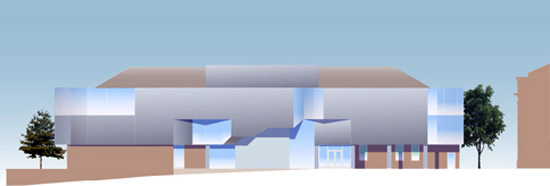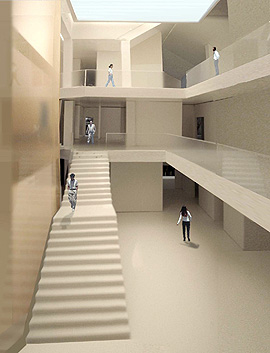Alumni Donate $500,000 to Wesleyan Museum
 |
| The new Wesleyan University Museum will provide a single secure, environmentally-controlled space to house valuable collections of art and materials. Pictured below is a cross section model of how the building will appear. The third-floor spaces will contain three gallery spaces and glass enclosed seating and study areas. |
| Posted 12/19/05 |
 Rick Segal ’75 and Monica Mayer Segal 78 have donated $500,000 toward the new Wesleyan University Museum, which will be built on College Row through an extensive remodeling of the historic former squash building. Rick Segal ’75 and Monica Mayer Segal 78 have donated $500,000 toward the new Wesleyan University Museum, which will be built on College Row through an extensive remodeling of the historic former squash building.
The new museum building, now in its final planning stages, will make an important architectural impact in the center of the campus. Three exterior walls of the former squash court building will be retained insuring the integrity of College Row. However, the west facade of the building facing Andrus Field will gain a dynamic new architectural expression featuring glass and metal. Rick and I both feel that there needs to be a stronger visual arts presence on the Wesleyan campus, and that an attractive, inviting, well-placed, user-friendly museum would do wonders to inspire undergraduates to enjoy the arts during their college years, and hopefully into their adult years, says Monica Mayer Segal, who, along with her husband Rick, is an avid art collector. We all know that Wesleyan students are attracted to arts and culture, so it seems a straight shot that they would make great use of a first class museum. The museum, which will cost approximately $23 million to complete, will provide a single secure, environmentally-controlled space to house valuable collections of art and material culture currently dispersed throughout the campus. These collections include more than 18,000 European and American prints, 600 Japanese prints and over 6,000 photographs displayed or stored in the Davison Art Center, as well as some 30,000 archeological and ethnographic items now housed in Exley Science Center, a collection of musical instruments from throughout the world now in storage in the Music Building, and a variety of Asian objects currently in the Mansfield Freeman Center for East Asian Studies. The need for a new museum building was signaled by the Collections Committee Advisory Report in 1997. The report indicated that Wesleyan was beyond reasonable capacity for its collections and that conservation demanded stricter standards of climate and light controls. In addition to new, secure exhibition spaces and much-needed expanded storage the museum will provide new lab spaces and study areas where students can work closely with objects in our collections under the guidance of the faculty and the curatorial staff, says John Paoletti, Kenan Professor of the Humanities, professor of art history and director of the new museum. More of our collections will be able to be shown on a regular basis, highlighting what are now some of Wesleyans best kept secrets. The new facility will also permit Wesleyan to borrow works of art from other institutions and alumni and alumnae collectors, enhancing the universitys exhibition program and teaching capabilities. The space will also include a new auditorium and reception area on the museums main floor. Paoletti has been on the Wesleyan faculty since 1972 and has seen the interest in the arts at Wesleyan and other institutions develop in extraordinary ways during that time. And yet, Wesleyan has been without an appropriate museum facility comparable to its peers. His enthusiasm for the museum is contagious, as the Segals soon discovered. We had been talking with the administration about this project for a few years, and it had gone through several permutations, but when John got involved it all coalesced for us, says Rick Segal. Johns vision for the physical component of the museum and his programmatic ideas are very exciting. Paoletti is most excited about the impact that the museum will have on Wesleyans educational programs. Weve recently had sophomore and juniors who have had internships at The Museum of Modern Art, the Whitney Museum, the Frick Collection in New York City, the Museum of Fine Arts in Boston, and the Chicago Art Institute, just to name a few, says Paoletti. Many of our students have gone on to prestigious positions in the gallery and museum world and in academics. The new museum will improve our ability to provide more extensive teaching opportunities and give our educational programs a very public face to the world outside Wesleyan. Paoletti does not have an exact date for the museums completion, though the gutting of the old squash courts has already begun as part of the work being done for the Susan Lemberg Usdan University Center, which will be next door to the museum. The speed at which will be able to move this project along will be strongly linked to the support we receive from alumni and friends of the university who want to make it a reality, says Paoletti. Rick and Monica have helped us take a very big first step, and for that we are all very grateful. I am anxious to seize the momentum they have created to keep the museum project moving forward in a creative and expeditious manner. For more information about the Wesleyan University Museum please go to: http://www.wesleyan.edu/masterplan/teaching.html. For illustrations of the Wesleyan University Museum please go to: http://www.wesleyan.edu/masterplan/teaching_detail.html. |
| By David Pesci, director of Media Relations |

